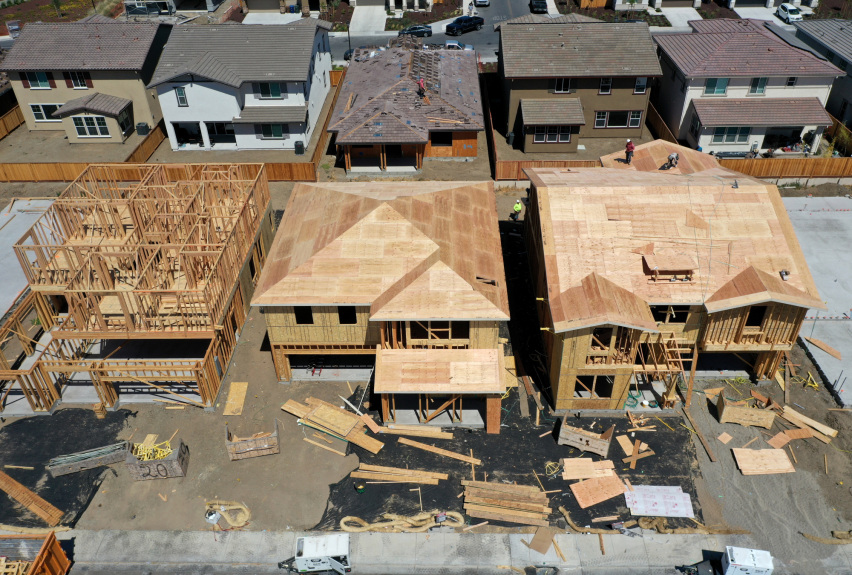Who’s fighting new housing? Look to wealthier Bay Area communities

Dublin has been booming in the past two decades, regularly topping the list of fastest-growing cities in California. Thousands of suburban homes have sprouted on once-fertile farmland.
The population of the East Bay bedroom community has grown nearly 50% over the past decade, and city leaders approved nearly twice as many homes and apartments as suggested by the state.
But in May, regional planners released a new set of goals and charged Dublin with building another 3,700 homes within the next decade.
“Where to put another 3,700 units of housing? That’s the puzzle,” said Dublin City Manager Linda Smith. While other Bay Area cities were fighting growth, she said, Dublin has been a poster child for development. “We’ve done all the right things,” she said, yet, “we’re being penalized.”
More than one-quarter of Bay Area municipalities are rising in a crescendo of complaints against proposed state guidelines for housing development that could reshape the region’s downtowns and neighborhoods. Cities can lose some local control over development for failing to meet new housing goals under the Regional Housing Needs Allocation process.
The appeals are a gauge of how willing Bay Area communities are to embrace or reject residential projects in the face of statewide and regional housing shortages. The responses also could be a preview of which cities plan for dense, new neighborhoods and apartment towers, and which will dig in for long, costly legal battles to protect the status quo.
The Bay Area’s largest cities — San Jose, San Francisco and Oakland — have accepted their ambitious housing goals while grappling with growing homeless populations and roadside tent and RV encampments.
“There’s an understanding in the bigger cities that growth is needed and growth is necessary,” said Matt Regan, vice president of public policy at the Bay Area Council. “They look at our failures every day.”
Across the region, 27 towns, cities and counties filed formal appeals with the Association of Bay Area Governments last month, seeking to lower new housing goals. Among those seeking the biggest reductions are Saratoga, Los Altos and Los Altos Hills, Palo Alto, the cities of Alameda, Lafayette, Pleasant Hill and most of Marin County.
“The appeals are very heavily concentrated in the wealthiest communities,” said Aaron Eckhouse of the pro-housing group California YIMBY. The group found 11 of the 18 cities with the highest median household incomes in the region are protesting their housing allotment. “Not a huge surprise.”
The appeals, disputes, fights and policy skirmishes could play a large role in how and where Bay Area cities develop new homes and apartments during the next decade. Amid record-high home prices and rents, economists and planners are urging more development or the region will risk stifling its innovative and booming economy.
The draft allocation is one step in the years-long RHNA process to determine how much and what type of residential growth a community should allow for. Bay Area planners dived into the minutiae and released an initial assessment of housing needs for each county and city. Planners sought to bring more development around transportation and employment hubs.
The region’s overall goal more than doubled to 441,000 new homes and apartments for the next 8-year cycle beginning in 2023. Many Bay Area cities have failed to reach their goals in previous cycles. But now state lawmakers have adopted tougher penalties for cities missing their targets. State planners estimate California is short millions of housing units to serve its population.
The effort by individual communities to reduce housing commitments is a zero-sum game — the overall Bay Area target remains the same. If one locality is successful in its appeal, another town, city or county gets a correspondingly higher goal.
Slow-growth communities have enlisted their planners, politicians and grassroots supporters in the battle. Their complaints largely argue that higher development targets are unrealistic and based on faulty assumptions, methods and overlooked data.
Monte Sereno, for example, wants to cut in half its assigned target to build 193 new homes and apartments by 2031. That is triple its previous goal. Officials in the small community, where the median home value is $3.7 million, argue the target “is beyond the capabilities of Monte Sereno’s city government to accommodate.”
Monte Sereno planners note the city has very few employers, already has far more homes than jobs, and has little access to buses and trains to shuttle workers to employment centers.
Mill Valley is seeking to cut its housing allotment by one-third, arguing new development would be at heightened risk for wildfires and flooding. Mayor John McCauley said staff had put an extraordinary amount of work into planning for future growth. “It’s disheartening to have numbers brought to us that are so unattainable,” he said.
A few counties appealed, including Santa Clara and Contra Costa, saying they are concerned about a lack of roads, water and sewers. Santa Clara County planners say the analysis did not account for the county’s agreements to work with cities on acquiring land for future development.
No city in San Mateo County disputed the allocations. San Jose has embraced the target of 35,000 new homes — almost double its last target.
“We were actually anticipating much higher numbers,” said deputy planning director Michael Brilliot. The city expects the completion of several major apartment towers and complexes downtown and around Diridon Station in coming years. “We’ve been planning for a lot of housing for a long, long time.”
Planners and elected leaders do not expect a wave of successful challenges.
In Dublin, city leaders want to register their objection. “We definitely believe we should get a little bit of credit,” Smith said. Ultimately, she added, “We’re going to do what we need to do.”

